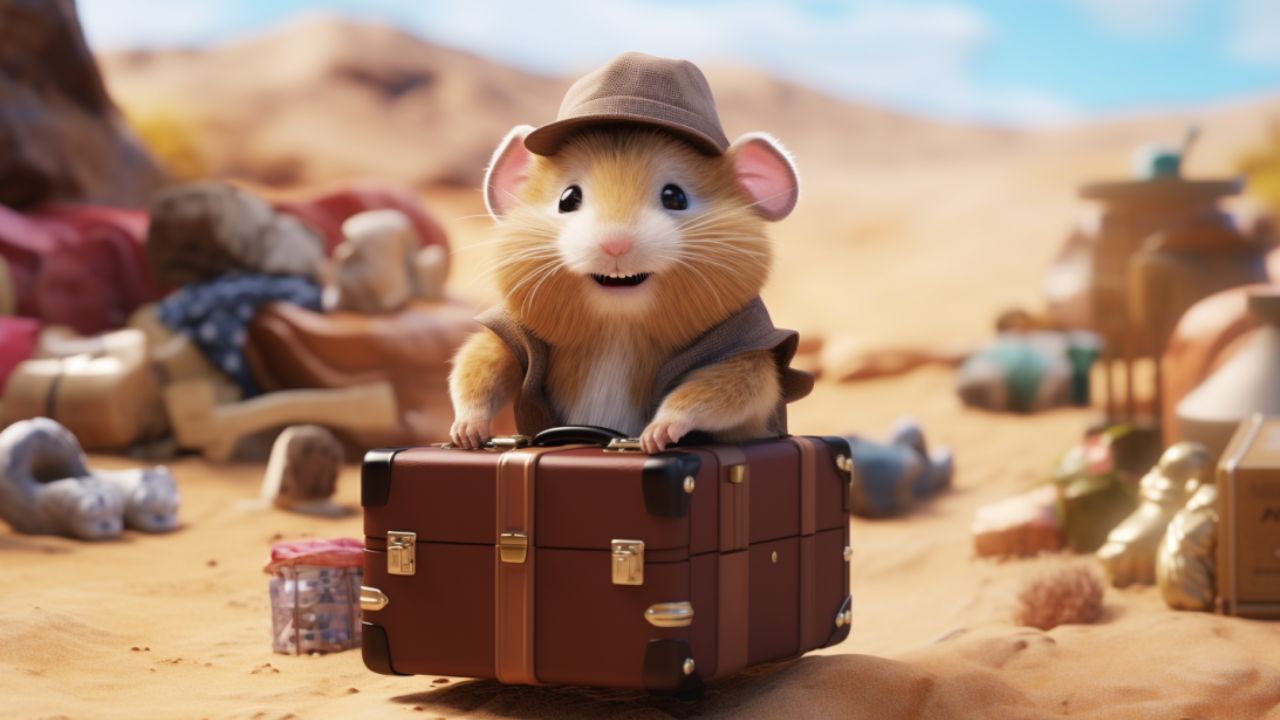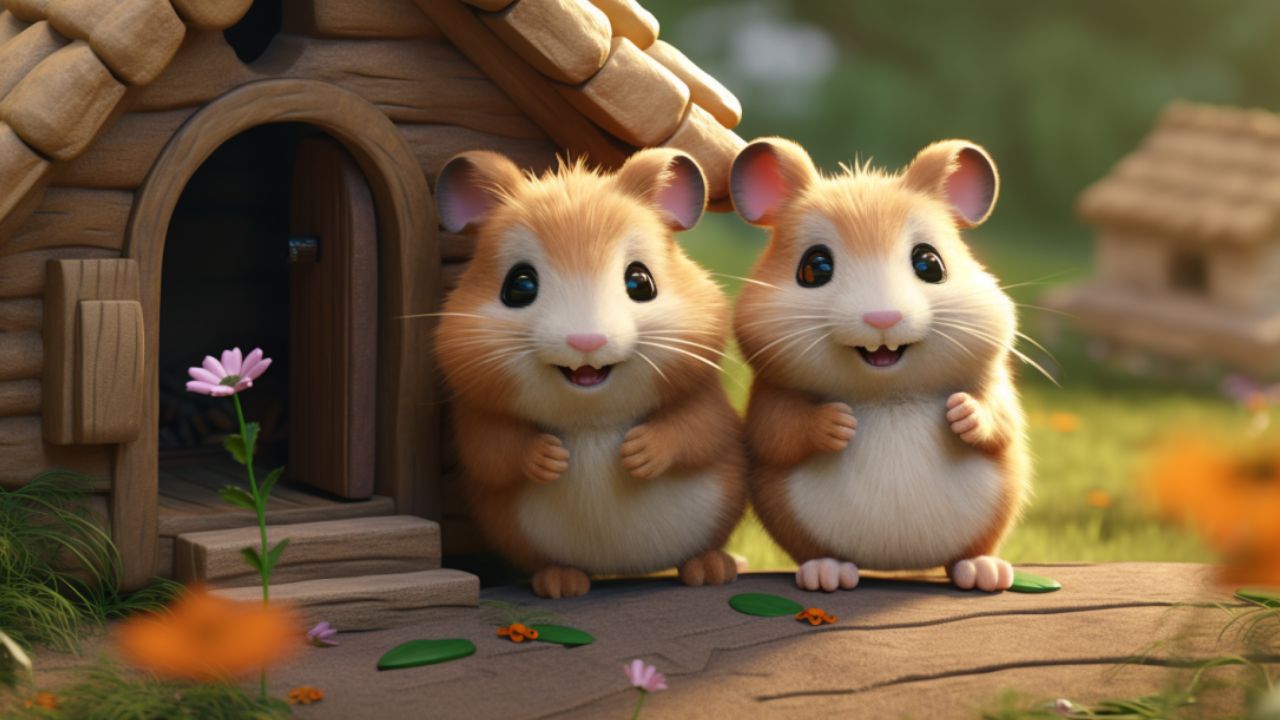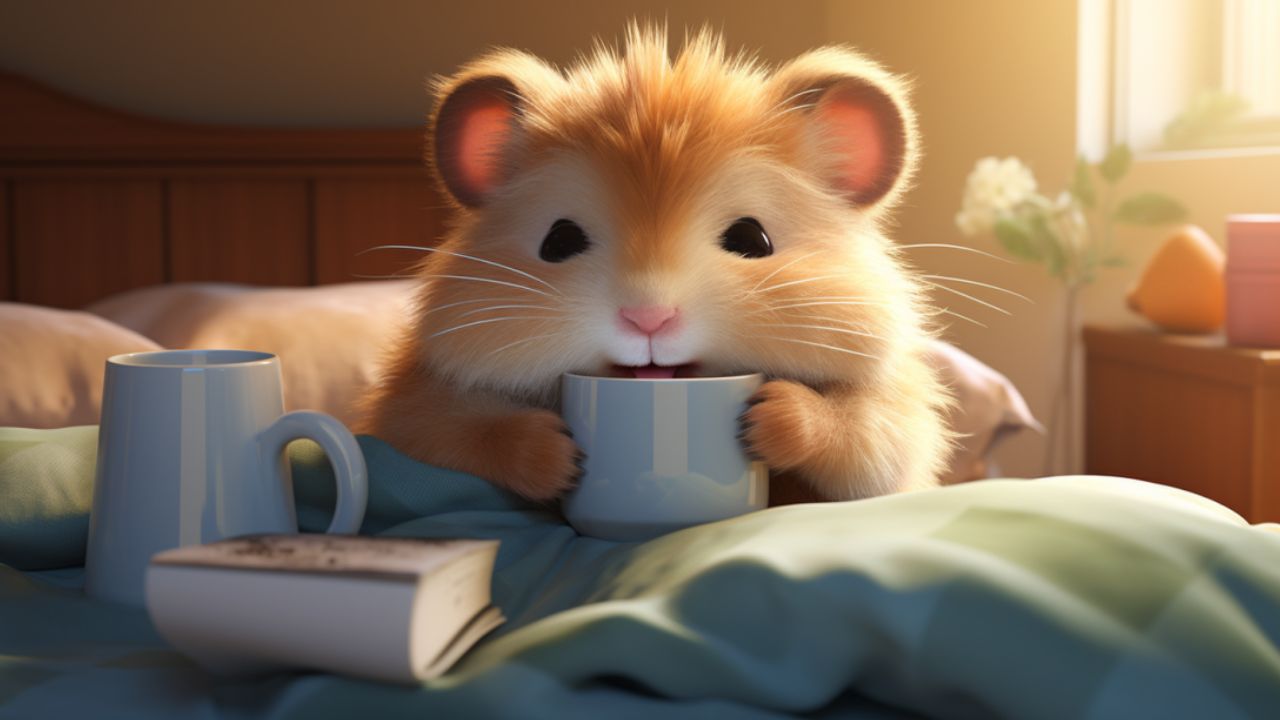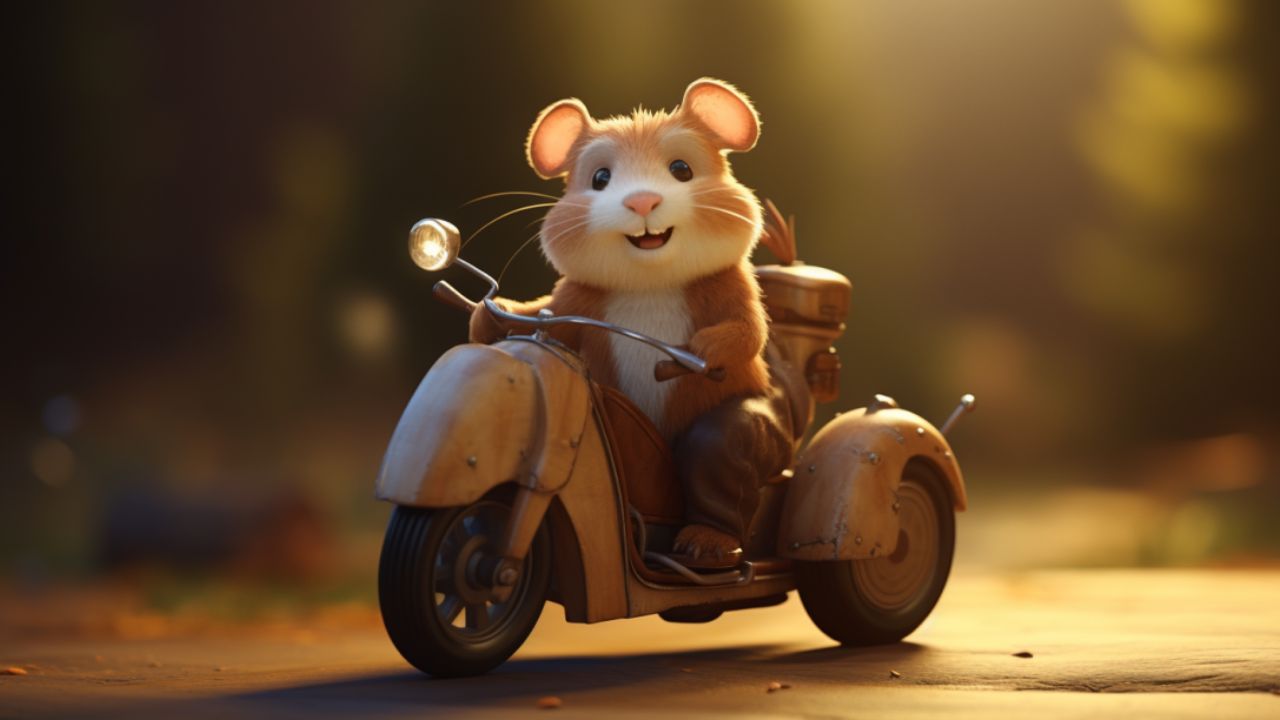Welcome to the vast and fascinating universe of the Campbell’s Dwarf Hamster. These diminutive creatures, with their beguiling eyes and delicate whiskers, have ensnared the hearts of countless individuals across the globe. But their allure extends far beyond their undeniable charm. Their captivating history, evolutionary journey, and unique behaviors make them one of the most intriguing species in the rodent realm.
Unraveling the Enigma of the Campbell’s Dwarf
The Campbell’s Dwarf Hamster, scientifically known as Phodopus campbelli, is a creature of wonder. It’s a marvel how so much charisma, adaptability, and resilience can be packed into such a petite frame. Tracing back their lineage, one discovers tales of survival amidst the vast steppes of Central Asia, evoking images of tiny warriors battling the elements. Their natural instincts, honed over millennia, have equipped them not only to survive but to thrive in diverse environments, from their native wild habitats to the cozy confines of our homes.
Mapping Our Expedition
As we embark on this comprehensive journey, we’ll be delving into every facet of the Campbell’s Dwarf Hamster world. We will explore the sweeping terrains they once roamed freely, the vibrant palette of their fur coats, and the intricate dance of their social interactions. Moreover, our expedition will guide potential and current pet owners through the nuances of caring for these mesmerizing creatures. Whether you’re a seasoned hamster enthusiast or a novice just starting out, this guide promises a blend of scientific insights, captivating anecdotes, and practical care tips. And while the world of hamsters is vast, with many species each boasting its own unique traits, our emphasis will remain steadfastly on the singular magic of the Campbell’s Dwarf.
Overview

The world of rodents is vast, diverse, and undeniably fascinating. Yet, within this realm, the Campbell’s Dwarf Hamster stands out as a species that has captured the imagination and hearts of many. While its size may be diminutive, its impact in both the wild and our homes is truly immense.
The Essence of the Campbell’s Dwarf
Known scientifically as Phodopus campbelli, the Campbell’s Dwarf Hamster is a treasure trove of unique characteristics and behaviors. Native to the sweeping terrains of Central Asia, including regions such as Northeast China, Mongolia, and parts of Russia, these hamsters have evolved to thrive amidst a range of environmental challenges. Their fur, which can vary from a muted grey to sandy brown, often with a dorsal stripe running along their spine, is a testament to their adaptability, offering both camouflage against predators and protection from the elements.
Their size, typically ranging from 3.5 to 4.5 inches in length, might suggest vulnerability, but don’t be mistaken. These hamsters are a paragon of resilience, with sharp senses and agile bodies that allow them to navigate their surroundings with astuteness, whether in the wild or within the confines of a human-made habitat.
From Steppes to Living Rooms
The journey of the Campbell’s Dwarf Hamster from the vast steppes of Central Asia to the cozy corners of our homes is a tale of two worlds. In the wild, they are masters of survival, adept at foraging for seeds, fruits, and occasional insects, while deftly evading predators and adapting to the ever-changing climate. Their intricate burrows, often a maze of tunnels and chambers, serve as both refuge and storage for the harsher months.
Yet, in households across the globe, they’ve transitioned from being elusive wild creatures to beloved companions. Their endearing behaviors, combined with their relatively low maintenance needs, have made them a popular choice for families, individuals, and especially children. Their inquisitive nature, often seen as they explore their cages or run tirelessly on wheels, along with their gentle demeanor when handled with care, has solidified their place in the pantheon of cherished pets.
However, this dual existence also underscores the importance of understanding and respecting their natural instincts, even when they are miles away from their native habitats. Whether in a grassy plain or a suburban living room, the essence of the Campbell’s Dwarf Hamster remains unaltered: a creature of wonder, resilience, and infinite charm.
Natural Habitat

When one visualizes the humble abode of the Campbell’s Dwarf Hamster, the images that might first come to mind could be of cozy cages or elaborate enclosures designed by doting human caregivers. However, the true origins of these intriguing rodents paint a picture far removed from the comfort of human homes. It’s a world of vast terrains, fluctuating climates, and the relentless dance of survival.
Landscapes of Resilience: The Campbell’s Native Terrain
The Campbell’s Dwarf Hamster’s ancestral lands stretch across the vast steppes and semi-arid regions of Central Asia. This includes the expansive landscapes of Northeast China, parts of Mongolia, and certain Russian territories. Here, the land is a tapestry of low grasses, shrubs, and the occasional tree, interspersed with patches of sand and loose soil. It’s a realm where the horizon stretches endlessly, punctuated occasionally by the silhouette of a distant hill or the shadow of a soaring bird.
In these regions, the Campbell’s Dwarf Hamster has crafted a life that capitalizes on the land’s offerings. The sparse vegetation becomes both shelter and food source, while the sandy and loamy soil offers the perfect medium for their intricate burrows. These burrows are more than just homes; they’re lifelines, offering protection from predators, shelter from the elements, and storage for food.
Dancing with the Seasons: Climate and Conditions
The Central Asian steppes, while captivating in their vastness, are lands of climatic extremes. Summers can be warm, with temperatures occasionally soaring, while winters bring with them a biting cold, sometimes accompanied by snow. This stark duality has shaped many facets of the Campbell’s Dwarf Hamster’s behavior and physiology.
Their fur, for instance, is not just a cosmetic feature. It serves as insulation, keeping them warm during the chilly months and protecting them from the harsh sun during warmer periods. Their nocturnal nature, where they are most active during the twilight hours, is also a nod to their environment, allowing them to forage and explore when temperatures are most moderate.
Furthermore, their diet in the wild, consisting of seeds, plant matter, and occasional insects, reflects the availability of resources in their natural habitat. Their cheek pouches, a defining feature, enable them to gather and store food efficiently, ensuring they have supplies during leaner times or when the weather turns inclement.
In essence, the habitat of the Campbell’s Dwarf Hamster is a testament to nature’s paradoxes: it’s both challenging and nurturing, vast yet intimate. And within this realm, the hamster has carved out a niche, showcasing its adaptability, resilience, and unyielding spirit.
Physical Characteristics

In the realm of rodents, each species possesses its own unique set of attributes that make them distinctive. For the Campbell’s Dwarf Hamster, their physical characteristics are not just markers of beauty but also tell tales of evolution, adaptation, and survival.
Dimensions of Delicacy: Size and Proportions
One of the first things that stands out about the Campbell’s Dwarf Hamster is its size—or perhaps more aptly, its lack thereof. Typically, these hamsters measure between 3.5 to 4.5 inches in length. Despite their diminutive stature, they are robustly built, exuding a certain vitality and energy that seems almost disproportionate to their size. Their petite frame is complemented by a relatively short tail, which is often obscured by their dense fur, making it barely visible.
Kaleidoscope of Coats: Color Variations
Nature’s palette shines brilliantly when it comes to the Campbell’s Dwarf Hamster’s fur. While the wild type typically flaunts a grey or sandy brown coat, often adorned with a distinguishable dorsal stripe that runs along their spine, years of selective breeding in captivity have introduced a spectrum of colors and patterns. From opal to blue, white-faced to mottled, there’s a veritable rainbow of fur variations in the domesticated world. Each variation, while primarily cosmetic in nature, adds another layer of charm to an already enchanting creature.
Features That Fascinate
Beyond size and color, the Campbell’s Dwarf Hamster boasts an array of features that are both functional and aesthetically pleasing:
- Eyes: Their eyes, round and shiny, exude a sense of wonder and curiosity. They serve as keen sensors, especially in dim light, given their nocturnal nature.
- Ears: Positioned slightly to the side, their ears are alert and often twitch in response to sounds, indicative of their sharp auditory senses.
- Cheek Pouches: Perhaps one of the most endearing features, these pouches can stretch to an impressive size, allowing the hamster to gather and transport food back to its burrow. When filled, they give the hamster a rather amusing, chubby-cheeked appearance.
- Teeth: Like other rodents, their incisors are ever-growing, necessitating regular gnawing to keep them in check.
In essence, every facet of the Campbell’s Dwarf Hamster’s physicality is a blend of form and function, showcasing nature’s impeccable design prowess.
Diet and Nutrition

The cornerstone of a healthy, vibrant Campbell’s Dwarf Hamster lies not just in its environment or genetics, but prominently in its diet. Proper nutrition ensures that these tiny creatures are endowed with the energy and vitality they need to thrive. But what exactly do these hamsters eat? And are there specific dietary considerations one must bear in mind?
Fare of the Fields: Typical Foods
The natural diet of the Campbell’s Dwarf Hamster in the wild encompasses a diverse range of foods. Their omnivorous nature means they are equipped to derive nutrition from both plant and animal sources:
- Seeds and Grains: These form the backbone of their diet. From millet to sunflower seeds, oats to wheat, these provide essential carbohydrates and fats.
- Fruits and Vegetables: In moderation, fresh produce can be a delightful treat. Favorites include broccoli, cucumbers, and apple slices (sans seeds). However, it’s essential to ensure that all fresh foods are introduced gradually and are free from pesticides.
- Proteins: In the wild, they might consume small insects or larvae. In captivity, occasional servings of mealworms or boiled eggs can suffice.
- Nuts: While they adore them, due to their high-fat content, nuts like walnuts or hazelnuts should be given sparingly.
Special Dietary Considerations
Understanding the general diet is just one piece of the puzzle. Delving deeper, there are particular nuances and preferences that a conscientious hamster guardian should be aware of:
- Water: Often overlooked, clean, fresh water is indispensable. It should be available at all times, ideally in a drip-feed bottle to maintain cleanliness.
- Avoid Sugary Foods: Campbell’s Dwarf Hamsters are prone to diabetes. Thus, sugary foods or fruits high in sugar (like grapes) should be avoided.
- Balanced Commercial Foods: While it might be tempting to only feed them with fresh produce and seeds, a high-quality commercial hamster mix ensures they get all the essential nutrients in the right proportions.
- Calcium and Minerals: To support bone health and overall well-being, mineral and calcium blocks can be added to their environment. They not only provide essential nutrients but also serve as a gnawing tool to keep their ever-growing teeth in check.
- Limit Fresh Foods: Fresh foods, if left uneaten, can spoil. It’s advisable to remove any uneaten fresh food within 24 hours to prevent mold and bacterial growth.
In essence, the dietary needs of the Campbell’s Dwarf Hamster, while not overly complicated, require a mix of knowledge, observation, and adaptability. Regularly observing your hamster’s eating habits, noting any changes, and adjusting the diet accordingly will ensure a healthy, happy rodent companion.
Housing and Environment

A well-maintained habitat is pivotal to the well-being of the Campbell’s Dwarf Hamster. These habitats are not just shelters; they are their universes, places where they eat, play, rest, and explore. Designing an environment that mimics their natural habitat, whilst ensuring safety and comfort, can make all the difference in their overall health and happiness.
The Perfect Palace: Ideal Cage Dimensions
Size matters, especially when it comes to hamster habitats. A space that’s too small can lead to stress, obesity, and destructive behaviors. On the other hand, a space that’s too vast can overwhelm and stress them, especially if not structured right.
- Minimum Cage Size: For a single Campbell’s Dwarf Hamster, the cage should be at least 450 square inches of continuous floor space. Remember, bigger is almost always better.
- Height: While they aren’t as acrobatic as some of their hamster cousins, a little vertical space can be appreciated. However, ensure that the levels are not too high to prevent falls.
- Bar Spacing: The bars of the cage should not be more than 0.4 inches apart. This will prevent escape attempts and potential injuries.
Bedding Basics and Preferences
The choice of bedding is not only essential for comfort but also plays a vital role in their natural behaviors like burrowing and nesting.
- Paper-based Bedding: Soft, absorbent, and dust-free, paper-based beddings are ideal. They allow for burrowing and can be comfortably nested.
- Aspen Shavings: A suitable alternative, as long as they are dust-free.
- Avoid Pine and Cedar: These can emit oils and scents that can be harmful to hamsters. They can irritate their respiratory system and should be avoided.
- Depth: A depth of 2-3 inches is recommended. This allows them to burrow and nest comfortably.
Environmental Enrichments
To keep a Campbell’s Dwarf Hamster engaged, stimulated, and content, their environment should be peppered with elements that cater to their natural instincts.
- Wheel: An essential addition. Ensure it’s solid-surfaced, and a minimum of 6.5 inches in diameter. A larger wheel is better to prevent back issues.
- Tunnels and Hideouts: These mimic their natural burrowing instincts and provide them with spaces to rest and feel secure.
- Chew Toys: With teeth that never stop growing, they need materials to gnaw on. Untreated wooden toys are an excellent choice.
- Sand Bath: A small dish of hamster-safe sand can be a delightful addition. They roll and play in it, helping them keep their fur clean.
To encapsulate, the environment of a Campbell’s Dwarf Hamster is more than just a cage—it’s their sanctuary. Ensuring it’s spacious, engaging, and safe will pave the way for a fulfilling, joyous hamster life.
Health and Wellness

The petite stature and endearing demeanor of the Campbell’s Dwarf Hamster can sometimes veil the significant health considerations they require. Just as with any pet, these hamsters can face health challenges. However, with proper awareness, timely interventions, and preventive measures, many of these issues can either be averted or managed effectively.
Navigating Common Health Concerns
The Campbell’s Dwarf Hamster, though hardy, has its set of health vulnerabilities. Being informed can pave the way for better care and swift interventions.
- Diabetes: One of the most well-documented concerns for this species. Regular monitoring, avoiding sugary foods, and ensuring a balanced diet can mitigate the risks.
- Respiratory Issues: Often caused by dusty beddings or cold drafts. Ensuring a clean, warm, and draft-free environment is pivotal.
- Wet Tail: A severe diarrheal disease, it’s vital to keep their living quarters clean and stress-free. Early symptoms include a wet or soiled tail region and lethargy.
- Overgrown Teeth: Their teeth never cease growing. Providing ample chew toys and ensuring they’re gnawing regularly is crucial.
- Tumors and Cysts: While not overly common, they can occur. Regularly feeling your hamster (during their active periods) for lumps or bumps can aid in early detection.
Veterinarian Visits: Knowing When It’s Time
While a keen eye and preventive measures can evade many issues, there are moments when professional intervention becomes indispensable.
- Behavioral Changes: If your hamster starts behaving out of the ordinary, be it lethargy, aggression, or any other sudden change, it’s a red flag.
- Physical Symptoms: Any noticeable weight loss, difficulty in breathing, sores, lumps, or discharge from eyes or nose should prompt an immediate visit.
- Eating and Drinking Patterns: A deviation from their normal eating or drinking habits, especially if they stop altogether, requires urgent attention.
- Preventive Checkups: Even if your furry friend seems perfectly healthy, an annual vet visit can help catch potential issues before they become severe. Remember, hamsters age quickly, so yearly check-ups can be quite significant in their short lifespan.
In conclusion, the health and wellness of a Campbell’s Dwarf Hamster hinge on a blend of vigilant care, a conducive environment, and a willingness to seek professional advice when needed. Their tiny bodies can sometimes mask significant health concerns, so always err on the side of caution.
Breeding

Breeding Campbell’s Dwarf Hamsters is a multi-faceted process, amalgamating biology, environment, and ethics. While these hamsters are known to reproduce easily in captivity, responsible breeding goes beyond mere reproduction; it’s about ensuring the health, well-being, and humane treatment of both parents and offspring.
Setting the Stage: Breeding Conditions
Creating the right environment is pivotal to successful and stress-free breeding. Here are the components to consider:
- Age of Breeding: The ideal age for breeding Campbell’s Dwarf Hamsters is between 4 to 6 months. Past this age, especially for females, risks can escalate.
- Separate Cages: Introduce the male and female only when the female is in estrus, which is typically every four days. This can be determined by a lighter colored vaginal discharge.
- Neutral Territory: When introducing the pair for the first time, consider a neutral space to prevent territorial disputes.
- Observation: Always monitor their initial interactions. While some chasing is normal, any aggressive behavior mandates separation.
The Breeding Process: Methodologies
Understanding the process is crucial to ensure safety and success.
- Mating: Once introduced, if the female is receptive, mating will usually occur quickly. It’s not unusual for them to mate multiple times.
- Gestation: The gestation period for Campbell’s Dwarf Hamsters is about 18-20 days. It’s crucial to avoid stressing the pregnant female.
- Post-Birth: Once the babies are born, minimize disturbances. Only check on the nest if absolutely necessary. Avoid touching the pups for the first week.
- Weaning: Pups can be weaned off their mother’s milk around 3 weeks of age. Post-weaning, it’s pivotal to separate males and females to prevent inbreeding.
Ethics and Responsibilities
Venturing into breeding mandates a strong ethical foundation.
- Avoid Inbreeding: Breeding close relatives can lead to genetic issues in the offspring. Always ensure a diverse gene pool.
- Adoption and Rehoming: Before breeding, consider the offspring’s future. Do you have the capacity to care for them? If planning to rehome, ensure potential adopters are well-informed and responsible.
- Limit Breeding: Continuously breeding females can lead to health issues. Allow ample rest between litters.
- Avoid Unnecessary Breeding: With many hamsters already seeking homes, breed responsibly. Ask yourself if there’s a genuine need or if it’s merely for personal interest.
In essence, breeding Campbell’s Dwarf Hamsters is not just a biological process; it’s a commitment to life. From creating the right environment to understanding the intricate details of the breeding process, and upholding the ethics of breeding, each step is pivotal.
FAQs

The world of the Campbell’s Dwarf Hamster is rife with curiosity. As these little creatures scuttle their way into our hearts, numerous questions arise. Here’s a dive into the most commonly asked ones, providing clarity for both potential adopters and seasoned caregivers.
1. How long do Campbell’s Dwarf Hamsters live?
On average, Campbell’s Dwarf Hamsters have a lifespan of 1.5 to 2 years in captivity, provided they receive optimal care. However, like all living beings, their lifespan can be influenced by genetics, diet, environment, and overall health.
2. Are they sociable creatures?
Indeed, Campbell’s Dwarf Hamsters are among the more sociable hamster species. They can cohabit peacefully with same-sex siblings if introduced at a young age. However, as with any animal, disputes can arise, so it’s always crucial to monitor their interactions and have separate housing available if needed.
3. What’s the best way to handle my hamster?
Always approach with calm and slow movements. Let them sniff your hand first. Once they’re accustomed to your scent, gently scoop them from beneath. Handling sessions should be short initially, gradually increasing as they become more comfortable.
4. How often should I clean the cage?
A full clean, including changing the bedding, should be done every week. Spot cleaning, especially areas they use as toilets, should be done daily to maintain hygiene.
5. Can I feed them fruits and vegetables?
Yes, but in moderation. Fresh produce like carrots, broccoli, and apple slices (seeds removed) can be an occasional treat. Always avoid citrus fruits, onions, and anything high in sugar, as these hamsters are prone to diabetes.
6. Why is my hamster losing fur?
Fur loss can be attributed to various factors: age, mites, allergies, or even stress. It’s essential to consult a veterinarian to pinpoint the cause and get appropriate treatment.
7. Is it normal for them to sleep during the day?
Absolutely! Hamsters are crepuscular, meaning they’re most active during dawn and dusk. It’s normal for them to rest during the day.
8. Can they coexist with other pet species?
While they’re sociable among their species, it’s not advisable to house them with other pet species, especially predators like cats or dogs. Even in supervised settings, the mere presence of a predator can induce stress.
9. How can I enrich my hamster’s environment?
Introduce tunnels, climbing structures, and chew toys. Varied textures, like wooden bridges or smooth stones, can also add interest. Rotating toys and introducing novel items can keep their environment stimulating.
10. Are Campbell’s Dwarf Hamsters prone to any specific illnesses?
Yes, notably diabetes. Regular monitoring, a balanced diet, and routine veterinary checks can aid in early detection and management.
Conclusion

The realm of the Campbell’s Dwarf Hamster is as vast as it is intricate. With every segment of this article, we’ve attempted to shed light on the complexities and wonders of these delightful creatures. Let us now encapsulate the most salient takeaways and urge our readers towards informed and compassionate action.
Recap of Our Hamster Odyssey
Our exploration began with an introduction to the enchanting world of the Campbell’s Dwarf Hamster, delving deep into their natural habitats and emphasizing the unique characteristics that make them stand out among the rodent kingdom. The behavioral traits, diet, housing guidelines, and health considerations form the blueprint for optimal hamster care. Their breeding practices, when done ethically, ensure a continuum of their species in the most humane way possible.
A Plea for Mindful Sharing and Caring
It’s imperative that this information not remain within the confines of this article. Sharing this knowledge means shaping a community equipped to care for these hamsters in the best possible way. For every potential adopter or existing caregiver, understanding is the cornerstone of compassionate care. Let us pledge to adopt responsibly, recognizing the profound impact we have on these tiny lives.
In the end, our approach to pet care is a testament to our humanity. Remember, a happy hamster is a wheel-y happy you!

